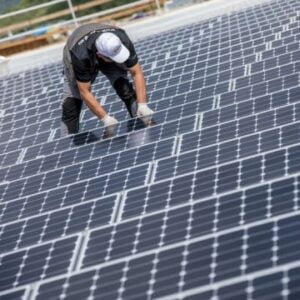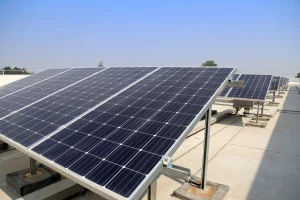
In land‑constrained Singapore, commercial solar photovoltaic (PV) systems are rapidly emerging as a smart strategy for businesses to reduce energy costs, cut carbon emissions and reinforce sustainability credentials.
With rising electricity tariffs, aggressive national carbon targets, and a growing network of government incentives, companies—from warehouses to strata‑managed buildings—are increasingly evaluating solar to strengthen both their financial returns and green reputation.
Yet, the optimal solar installation method can vary significantly based on site layout, structural readiness, energy demand and long‑term goals. Commercial solar panel installers typically choose among three types of mounting systems in Singapore:
-
Roof‑mounted systems
-
Ground‑mounted systems
-
Carport (parking canopy) systems
Selecting the best option requires careful consideration of capital expenditure (capex), operational complexity, available space and strategic business objectives. This first half lays out the pros and cons of roof and ground installations, with a full comparison and guidance to follow later.
2. Roof‑Mounted Solar Systems
What is it?
Roof‑mounted systems fix PV modules directly onto the roof structure—typically using rail-mounted or ballast (non‑penetrative) systems. These installations are especially common on flat roof commercial buildings, including warehouses, strata blocks and institutional properties.
Pros:
-
Minimised upfront capital
Because no land acquisition or additional supporting structures are required, roof systems are generally the least expensive. They leverage existing roof real estate, saving on installation complexity. -
Space‑efficient in urban settings
Given Singapore’s scarcity of land, roof installations maximise underutilised space without altering the footprint. -
Better security and tamper resistance
Elevated installations are harder to access, reducing risk of theft or vandalism. -
Secondary protection for roof surface
Panels act as a shade layer, reducing UV exposure and precipitation on the roof. This can extend roof lifespan when panels are suitably mounted.
Cons:
-
Structural constraints
A detailed structural survey must confirm the roof can handle the added load. Roofs nearing end‑of‑life or in poor condition may require reinforcement or replacement, adding to upfront cost. -
Challenging maintenance access
Repairs, cleaning or roof work often require partial panel removal, increasing maintenance effort and downtime. -
Sub‑optimal tilt/orientation
Many commercial roofs are flat and cannot achieve the ideal 10–15° tilt or east–west orientation. This can slightly reduce annual energy yield versus optimally tilted arrays. -
Grid integration concerns
Large rooftop export can introduce voltage rise, reverse flow and imbalance into local distribution networks—a particular concern for feeders on older low‑voltage grids.
Suitability in Singapore
Roofs are the most prevalent mounting choice in Singapore’s built environment. Their flat design allows adjustable tilt racks to boost performance. Many commercial buildings have metal‑stood roofing (e.g. insulated sandwich panels), which support clamp‑based rail systems without roof penetration. However, if your roof is structurally compromised or due for replacement, rooftop installations become less viable.
3. Ground‑Mounted Solar Systems
What is it?
Ground‑mounted systems use purpose‑built frames—often steel or aluminium—to support PV panels installed on open ground. These systems allow flexible orientation and tilt and are typically used for larger‑scale arrays.
Pros:
-
Optimised solar angle and orientation
Free from roof angle limitations, ground arrays can be oriented for peak insolation exposure—maximising yield and energy production efficiency. -
Easier access for maintenance
Installed at ground level, these systems simplify module cleaning, inverter service and panel replacement. -
Modular and scalable
Systems can be expanded in modules without roof constraints, ideal for businesses anticipating growth in solar capacity. -
No roof penetration or limitations
Avoids risk of roof leaks, structural stress and maintenance conflicts.
Cons:
-
Higher capital cost
Ground systems incur costs for foundations, substation wiring, fencing and possibly land development—even leasing in high‑value Singapore land. -
Land footprint conflicts
Without unused land or leftover space, carving out a plot for solar may compete with future development or storage usage. -
Security and vandalism risk
Ground arrays are more accessible, requiring fencing or CCTV—further adding to cost.
Suitability in Singapore

Ground mounting is feasible for facilities with adjacent vacant land—such as industrial parks, mega‑warehouses or rural fringe properties. However, Singapore’s land scarcity and high real estate values often limit the economic viability, unless the land is already owned or leased at low cost. Despite higher capex, the increased performance and scalability suit energy-intensive operations where long-term ROI is strong.
4. Summary Comparison (so far)
| Criterion | Roof‑Mounted | Ground‑Mounted |
|---|---|---|
| Upfront cost | Lowest | Higher (frame, land, fencing) |
| Use of space | Uses existing roof | Requires open land or leased area |
| Maintenance ease | Moderate (roof‑level) | Easier (ground‑level access) |
| Panel orientation flexibility | Limited by roof shape | Fully adjustable |
| Structural dependency | Roof load‑bearing required | Independent structure on ground |
| Scalability | Limited by roof footprint | Highly scalable |
| Security | More secure (elevated height) | Requires fencing |
5. Next Steps in Evaluation (for Singapore Business Owners / Facilities Managers)
-
Conduct a feasibility assessment:
Engage with a local solar engineering firm to assess roof condition, shading analysis, structural integrity, and energy demand profile. -
Run financial modelling:
Estimate upfront capex, projected energy yield, payback period, operating costs, and net present value for both roof and ground options. -
Understand local incentives:
Research grants, tax rebates or strata‑level schemes valid in 2025 (e.g. productivity schemes, energy‑conservation rebates, partial funding for solar retrofit). -
Prepare for compliance and safety:
Rooftop installs must meet BCA fire code requirements, corridor and escape access routes, PV layout restrictions, and drainage compliance.
6. Solar Carport Systems (Canopy Installations)
What is it?
Solar carports are elevated structures installed over car parks or open paved areas. They serve a dual function: acting as both covered parking and as a structure for mounting photovoltaic panels. The canopy height allows for regular vehicle clearance while optimising solar tilt and exposure.
Pros:
-
Dual-purpose design
Carports convert unproductive parking surfaces into energy-generating assets without altering land usage rights. They offer shade to cars and reduce heat buildup, improving user comfort. -
EV charger integration
Carports are ideal locations to integrate electric vehicle (EV) chargers directly powered by solar, helping future-proof commercial buildings as Singapore shifts towards EV adoption. -
Visible sustainability commitment
These installations are highly visible to employees, customers and investors, reinforcing environmental branding. This is especially useful for retail parks, hospitals and universities. -
Optimised tilt and tracking
Unlike rooftops limited by surface slope, carport systems can be tilted and oriented for maximum sun exposure, improving yield. -
No impact on existing buildings
Structural independence means they don’t add load to existing buildings, bypassing any roof integrity concerns.
Cons:
-
High capital cost
Carport structures require steel columns, concrete foundations, drainage systems and extensive cabling. In Singapore, these costs can exceed rooftop systems by 70–80%. -
Engineering and compliance complexity
Foundation depth must support wind loads and structural weight. Designs need URA and BCA approval, and installation often takes longer than roof systems. -
Larger space requirement
Requires a sizeable and open car park, often only found in business parks, retail plazas, or strata-titled estates with shared parking. -
Longer ROI period
Due to higher capex, payback periods are typically 8–12 years unless combined with premium EV charging or carbon offset initiatives.
7. Carport Systems in Singapore Context
In Singapore, carports are less common but rising in interest—particularly for strata developments, educational campuses and industrial buildings with extensive open parking. As the Land Transport Authority (LTA) continues rolling out public EV infrastructure, businesses with carports can benefit by integrating solar + EV charging as a value-added amenity.
Several solar engineering firms now offer modular carport systems compliant with Singapore’s building and fire codes, with integrated cable routing and inverter systems. However, due to the premium costs, these are best suited for clients with strong ESG mandates or significant open parking facilities.
8. Cost Benchmarking (Singapore-Adjusted Estimates)
| Installation Type | Approx. Cost per Wp (SGD) | Relative Cost | Avg. ROI Timeline |
|---|---|---|---|
| Rooftop | $1.50 – $2.00 | ★ Lowest | 5 – 7 years |
| Ground-Mount | $1.80 – $2.40 | ★★ Moderate | 6 – 8 years |
| Carport | $2.80 – $3.50 | ★★★ Highest | 8 – 12 years |
Note: Actual cost varies based on system size, inverter type, mounting method, BMS integration, and site accessibility. Higher capacity systems (>100kWp) enjoy economies of scale. Singapore’s tropical climate (no snow load) reduces structural requirements versus other countries, but space and regulatory compliance add complexity.
9. Full Comparison Summary Table
| Factor | Rooftop | Ground-Mount | Carport |
|---|---|---|---|
| Capex | Low | Medium | High |
| Land Use | Utilises existing roof | Requires vacant land | Requires open parking lot |
| Installation Complexity | Moderate | Moderate | High |
| Maintenance Access | Moderate | Easy | Moderate |
| Panel Orientation | May be suboptimal | Fully adjustable | Fully adjustable |
| Aesthetic/Brand Value | Hidden from view | Hidden unless landscaped | Highly visible & brandable |
| Dual-Use Potential | None | None | Yes (shade + EV charging) |
| Security | High | Lower (ground-level risk) | Medium |
| Best Use Case | Warehouses, strata roofs | Large land plots/factories | Retail/commercial w/ car parks |
10. Singapore Case Applications
✅ Use Case A: Light Industrial Facility
-
Roof Type: Flat concrete with strong beam load
-
Available Land: None
-
Energy Demand: High base load
-
Recommended Install: Rooftop, 200kWp monocrystalline system with 12° tilt rails
✅ Use Case B: Manufacturing Plant with Vacant Land
-
Roof Condition: Asbestos/old zinc roof, not viable
-
Land: Adjacent 1,200 sqm available
-
Recommended Install: Ground-mount with bifacial modules and central inverter, expandable to 500kWp
✅ Use Case C: Business Park with Car Park
-
Roof Space: Fully used for HVAC
-
Parking Bays: 80+
-
Branding Goal: Strong ESG push
-
Recommended Install: Carport system with integrated EV charging, 100kWp
11. Decision-Making Framework
To determine the best fit, follow these steps:
Step 1: Assess your site
-
Check roof age, structural condition and load capacity
-
Identify vacant land or parking space availability
Step 2: Define your energy goals
-
Is your load base or peak?
-
Need full offset or partial savings?
-
Consider load growth in next 5–10 years
Step 3: Analyse cost vs value
-
Run scenario planning for ROI, payback, and net savings
-
Factor carbon offset incentives, branding value, and future EV plans
Step 4: Engage a solar EPC consultant
-
Request site survey, CAD design, and financial projection
-
Include BMS integration, inverter selection, and system monitoring features
12. Final Recommendation
In Singapore’s dense, high-cost environment:
-
Rooftop installations are optimal for most commercial facilities with structurally sound roofs and minimal land.
-
Ground-mount systems are suitable only where large, idle land parcels exist—mainly in outskirts, high-energy-use sectors like logistics or manufacturing.
-
Carports offer premium dual-use value and visible sustainability leadership but require significant space and investment, best suited for car park-heavy properties or ESG-aligned organisations.
A thorough feasibility study—including load analysis, energy simulations, and long-term ROI projection—should precede any decision. Consider engaging with a certified solar engineering, procurement and construction (EPC) firm with local BCA and EMA experience.
Not sure which solar installation suits your building or facility?
First Solution Group provides detailed feasibility studies, solar modelling, and structural assessments to help you make the right decision—whether you’re managing a warehouse roof, an industrial land plot, or a large car park.
Our solar engineers are certified and backed by years of hands-on commercial project experience. Get a customised solar proposal built for Singapore’s regulatory and climatic conditions, and start generating clean, low-cost power with confidence. Contact us today.